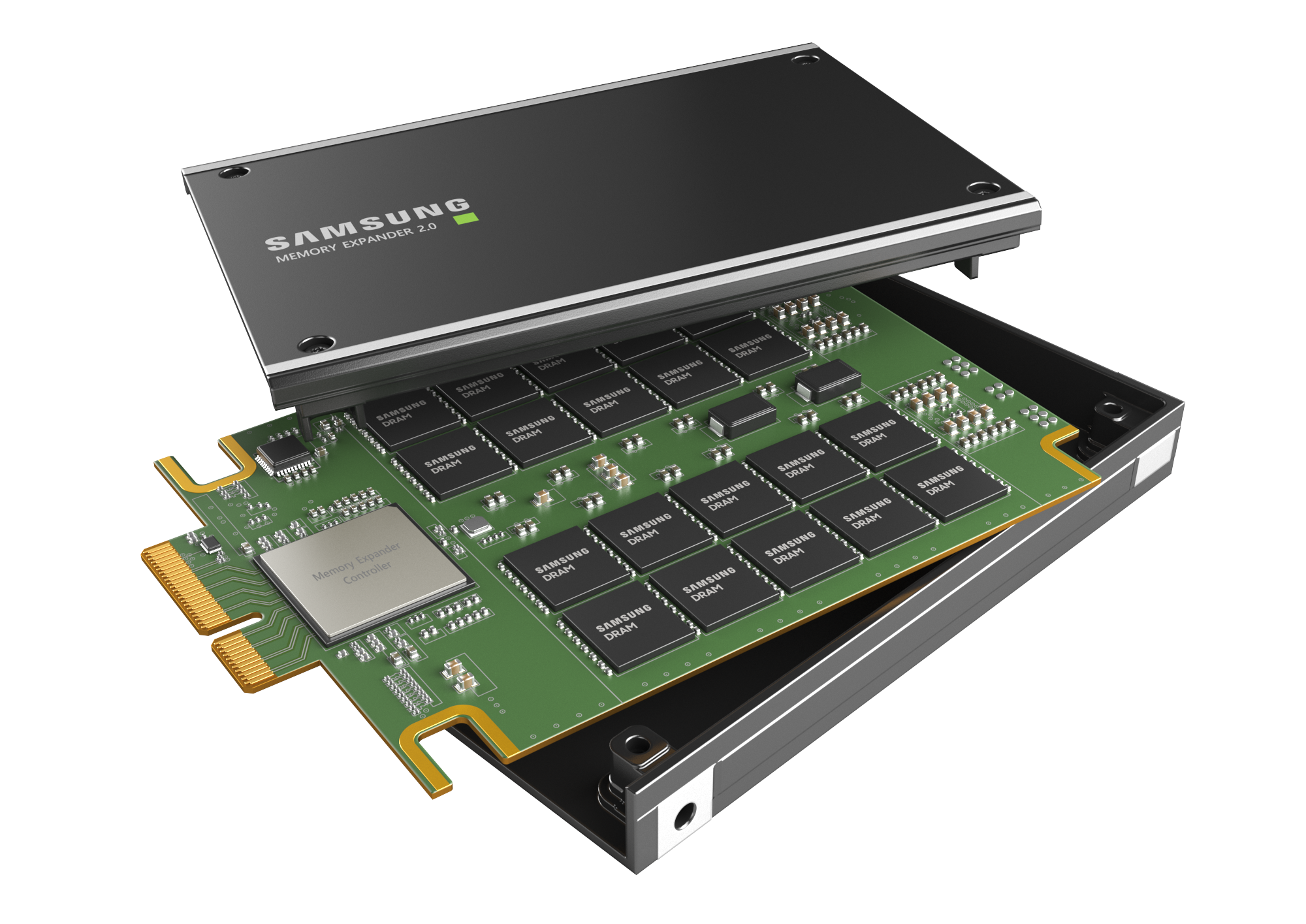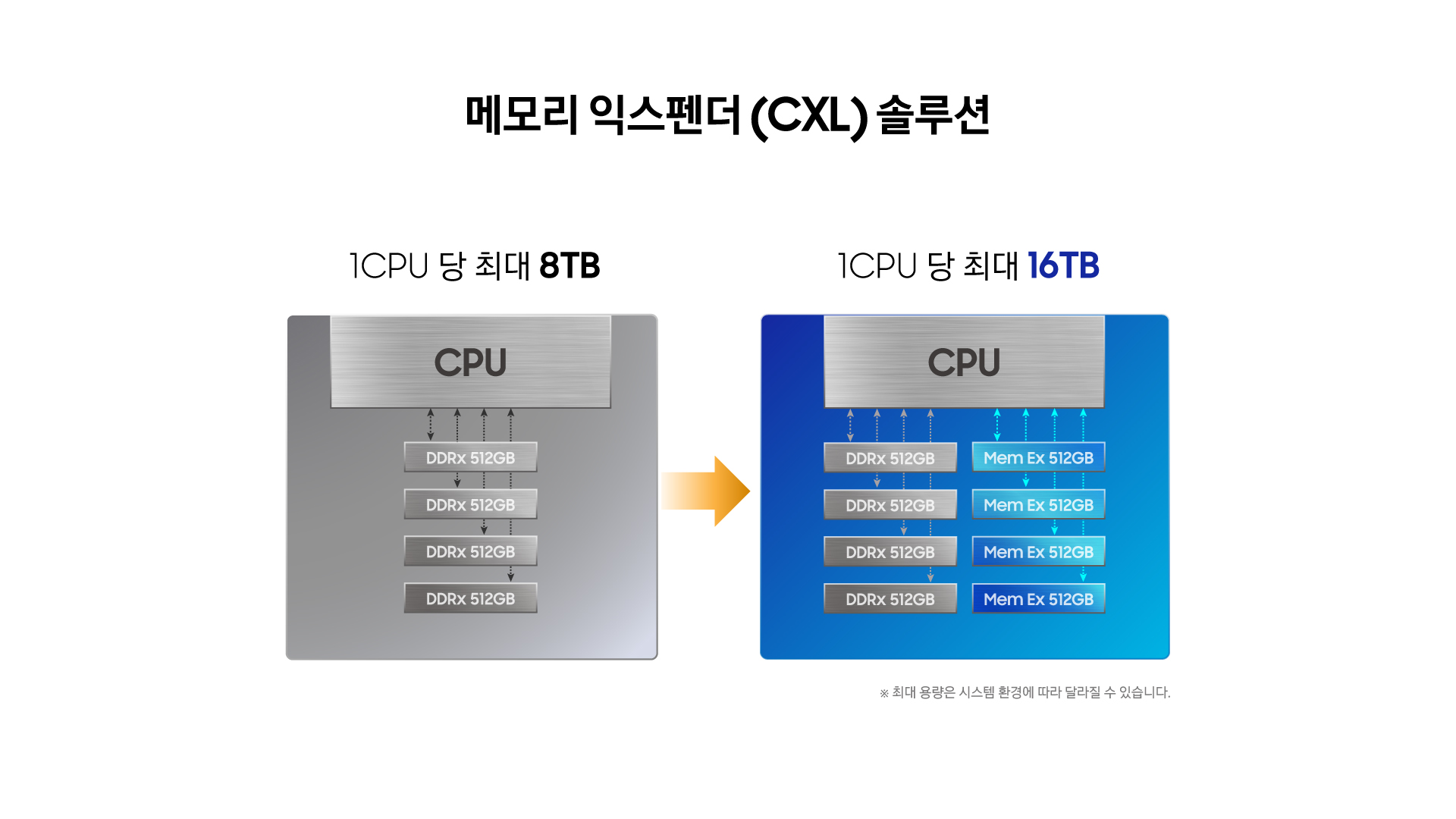삼성전자가 차세대 메모리 상용화에 앞장서는 행보를 보이고 있다. CXL 메모리 개발에서 앞서나가며 AI·메타버스 시대에 폭발적으로 증가하는 데이터양 처리와 고성능 컴퓨팅 시스템 효율 향상에 대한 시장요구를 충족시킬 수 있을 것으로 전망된다.

▲삼성 512GB CXL D램 (이미지 제공 - 삼성전자)
CXL D램 용량 4배 향상, 서버 한 대 수십 테라 확장 가능
삼성전자가 차세대 메모리 상용화에 앞장서는 행보를 보이고 있다. CXL 메모리 개발에서 앞서나가며 AI·메타버스 시대에 폭발적으로 증가하는 데이터양 처리와 고성능 컴퓨팅 시스템 효율 향상에 대한 시장요구를 충족시킬 수 있을 것으로 전망된다.
삼성전자는 10일 업계 최초로 고용량 512GB CXL D램을 개발했다고 밝혔다. 지난해 5월 세계 최초로 CXL 기반 D램 기술을 개발해 데이터센터, 서버, 칩셋 업체들과 평가를 해왔으며, 이번에 기존 대비 메모리 용량을 4배 향상시킨 512GB CXL D램을 개발했다고 부연했다.
또한 ASIC(주문형 반도체) 기반의 컨트롤러를 탑재해 데이터 지연 시간을 기존 제품 대비 1/5로 줄였다고 설명했다. 이번 제품은 PCIe 5.0을 지원하며, 대용량 SSD에 적용되는 EDSFF(Enterprise & Data Center Standard Form Factor) 폼팩터가 적용되어, 기존 컴퓨팅 시스템의 D램 용량을 보다 확장할 수 있게 됐다.
CXL은 고성능 컴퓨팅 시스템에서 CPU와 함께 사용되는 가속기, 메모리, 저장장치 등을 보다 효율적으로 활용하기 위해 새롭게 제안된 인터페이스로 최근 메타버스, 인공지능, 빅데이터 등 폭발적으로 증가하는 데이터양을 처리할 기술로 급부상했다. 기존의 DDR 인터페이스는 시스템에 탑재할 수 있는 D램 용량에 한계가 있어, CXL D램과 같은 차세대 메모리 솔루션에 대한 요구가 지속되는 상황이다.
삼성전자가 이번에 고용량 CXL D램을 개발함에 따라 메인 D램과 더불어 서버 한 대당 메모리 용량을 수십 테라바이트 이상으로 확장할 수 있게 됐다.

▲메모리 익스펜더 솔루션 (이미지제공 - 삼성전자)
삼성전자는 이달 중 '스케일러블 메모리 개발 키트(Scalable Memory Development Kit, SMDK)'의 업데이트 버전을 오픈소스로 추가 공개해, 개발자들이 다양한 응용 환경에서 CXL D램 기술을 활용하는 프로그램을 빠르고 쉽게 개발할 수 있게 할 계획이다.
차세대 이종 메모리 시스템 환경에서 기존에 탑재된 메인 메모리와 CXL 메모리가 최적으로 동작하도록 도와주는 소프트웨어 개발 도구인 SMDK는 API, 라이브러리 등으로 구성돼 있다.
그렉 허프 레노버 인프라스트럭쳐 솔루션그룹 최고기술책임자는 “CXL 컨소시엄의 멤버인 레노버는 기술 표준 개발과 함께 CXL 중심의 생태계 구축에 기여하고 있다”라며, “CXL 제품들을 레노버 시스템에 적용을 확대하는 데 삼성전자와 협력해 나가겠다”라고 말했다.
박철민 삼성전자 메모리사업부 신사업기획팀 상무는 “CXL D램은 인공지능, 빅데이터 등의 서비스를 혁신적으로 향상시키고, 향후 소프트웨어 정의 메모리를 포함한 차세대 메모리로 확장될 것”이라며, “삼성전자는 CXL 메모리 생태계가 빠르게 확장해 갈 수 있도록 기술 표준화를 적극 추진하고, CXL 메모리 솔루션을 확대해 차세대 메모리 시장을 주도해 나가겠다”라고 밝혔다.
한편, 삼성전자는 CXL 컨소시엄 이사회에 참여해 글로벌 주요 데이터센터, 서버, 칩셋 업체들과 함께 차세대 인터페이스 기술 개발을 위한 협력을 확대해 가고 있다.
또한 이번에 개발한 512GB CXL D램은 3분기부터 샘플을 제공할 예정이라고 밝혔다. 삼성전자는 테라바이트급 이상의 차세대 메모리 인터페이스 제품을 지속 개발하며 대용량 메모리가 요구되는 컴퓨팅 시장에 맞춰 적기에 상용화할 계획을 가지고 있다고 언급했다.

